Commando
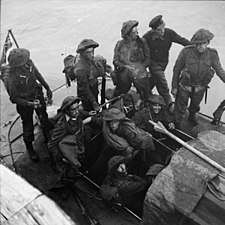
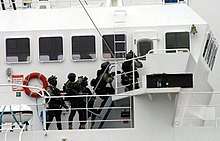

A commando is a soldier or operative of an elite light infantry or special operations force often specializing in amphibious landings, parachuting or abseiling.
Originally "a commando" was a type of combat unit, as opposed to an individual in that unit. In other languages, commando and kommando denote a "command", including the sense of a military or an elite special operations unit.
In the militaries and governments of most countries, commandos are distinctive in that they specialize in assault on unconventional high-value targets. However, the term commando is sometimes used in relation to units carrying out the latter tasks (including some civilian police units). Commandos differ from other types of special forces in that they primarily operate in overt combat, front-line reconnaissance, and raiding, rather than long range reconnaissance and unconventional warfare.
In English, occasionally to distinguish between an individual commando and the unit Commando, the unit is capitalized.[1]
Etymology
The word stems from the Afrikaans word kommando, which translates roughly to "mobile infantry regiment". This term originally referred to mounted infantry regiments, who fought against the British Army in the first and second Boer Wars.
It is also possible the word was adopted into Afrikaans from interactions with Portuguese colonies.[2] Less likely, it is a High German loan word, which was borrowed from Italian in the 17th century, from the sizable minority of German settlers in the initial European colonization of South Africa.[1]
The officer commanding an Afrikaans kommando is called a kommandant, which is a regimental commander equivalent to a lieutenant-colonel or a colonel.
The Oxford English Dictionary ties the English use of the word meaning "[a] member of a body of picked men ..." directly into its Afrikaans' origins:[3]
1943 Combined Operations (Min. of Information) i. Lt. Lieutenant-Colonel D. W. Clarke... produced the outline of a scheme.... The men for this type of irregular warfare should, he suggested, be formed into units to be known as Commandos.... Nor was the historical parallel far-fetched. After the victories of Roberts and Kitchener had scattered the Boer army, the guerrilla tactics of its individual units (which were styled ‘Commandos’)... prevented decisive victory.... His [sc. Lt.-Col. D. W. Clarke's] ideas were accepted; so also, with some hesitation, was the name Commando.
During World War II, newspaper reports of the deeds of "the commandos" led to readers thinking that the singular meant one man rather than one military unit, and this new usage became established.
History
After the Dutch Cape Colony was established in 1652, the word was used to describe bands of militia. The first "Commando Law" was instated by the original Dutch East India Company chartered settlements and similar laws were maintained through the independent Boer Orange Free State and South African Republic. The law compelled Burghers to equip themselves with a horse and a firearm when required in defense. The implementation of these laws was called the "Commando System". A group of mounted militiamen were organized in a unit known as a commando and headed by a Commandant, who was normally elected from inside the unit.[1] Men called up to serve were said to be "on commando".[4] British experience with this system led to the widespread adoption of the word "commandeer" into English in the 1880s.[5]
During the "Great Trek", conflicts with Southern African peoples such as the Xhosa and the Zulu caused the Boers to retain the commando system despite being free of colonial laws. Also, the word became used to describe any armed raid. During this period, the Boers also developed guerrilla techniques for use against numerically superior but less mobile bands of natives such as the Zulu who fought in large, complex formations.[1]
In the First Boer War, Boer commandos were able to use superior marksmanship, fieldcraft, camouflage and mobility to expel an occupying British force (poorly trained in marksmanship, wearing red uniforms and unmounted) from the Transvaal. These tactics were continued throughout the Second Boer War. In the final phase of the war, 75,000 Boers carried out asymmetric warfare against the 450,000-strong British Imperial forces for two years after the British had captured the capital cities of the two Boer republics. During these conflicts the word entered English, retaining its general Afrikaans meaning of a "militia unit" or a "raid". Robert Baden-Powell recognised the importance of fieldcraft and was inspired to form the scouting movement.
In 1941, Lieutenant-Colonel D. W. Clarke of the British Imperial General Staff, suggested the name Commando for specialized raiding units of the British Army Special Service in evocation of the effectiveness and tactics of the Boer commandos.[1] During World War II, American and British publications, confused over the use of the plural "commandos" for that type of British military units, gave rise to the modern common habit of using "a commando" to mean one member of such a unit, or one man engaged on a raiding-type operation.[1]
Green Berets and training origins
Since the 20th century and World War II in particular, commandos have been set apart from other military units by virtue of their extreme training regimes; these are usually associated with the awarding of green berets which originated with British Commandos. The British Commandos were instrumental in founding many other international commando units during World War II. Some international commando units were formed from members who served as part of or alongside British Commandos, such as the Dutch Korps Commandotroepen (who still wear the recognition flash insignia of the British Fairbairn-Sykes Fighting Knife), the Belgian 5th Special Air Service, or Greek Sacred Band (World War II). In 1944 the SAS Brigade was formed from the British 1st and 2nd SAS, the French 3rd and 4th SAS, and the Belgian 5th SAS. The French Army special forces (1er RPIMa) still use the motto Qui Ose Gagne, a translation of the SAS motto "Who Dares Wins."
In addition, many Commonwealth nations were part of the original British Commando units. They developed their own national traditions, including the Australian Special Air Service Regiment, the New Zealand Special Air Service, and the Southern Rhodesian Special Air Service, all of whom share (or used to) the same insignia and motto as their British counterparts. During the Second World War, the British SAS quickly adopted sand-coloured berets, since they were almost entirely based in the North African theatre; they used these rather than green berets to distinguish themselves from other British Commando units. (See History of the Special Air Service). Other Commonwealth commando units were formed after the Second World War directly based on the British Commando units, such as the Australian 1st Commando Regiment (Australia), distinct from the Australian special operations 2nd Commando Regiment (Australia), who originated with the jungle-fighting 2nd Battalion, Royal Australian Regiment during the Second World War.
The US Rangers were founded by Major General Lucian Truscott of the US Army, a liaison officer with the British General Staff. In 1942, he submitted a proposal to General George Marshall that an American unit be set up "along the lines of the British Commandos". The original US Rangers trained at the British Commandos centre at Achnacarry Castle. The US Navy SEALs' original formation, the Observer Group, was also trained and influenced by British Commandos.[6] The US Special Forces originated with the First Special Service Force, formed under British Combined Operations.
Malaysian green beret special forces PASKAL[7] and Grup Gerak Khas (who still wear the Blue Lanyard of the Royal Marines) were originally trained by British Commandos. The Brazilian marine special operations COMANF also originated with Royal Marines mentoring. Other British units, such as the SAS, led to the development of many international special operations units that are now typically referred to as commandos, including the Pakistani Special Services Group, the Indian MARCOS, and the Jordanian special forces.
World War I
Austro-Hungarian assault units
During the winter of 1914–1915 large parts of the Eastern Front switched to trench warfare. To cope with the new situation many Austro-Hungarian regiments spontaneously formed infantry squads called Jagdkommandos. These squads were named after the specially trained forces of Russian army formed in 1886 and were used to protect against ambushes, to perform reconnaissance and for low intensity fights in no-man's-land.
Austro-Hungarian High army command (Armeeoberkommando, AOK) realized the need for special forces and decided to draw on German experience. Starting in September–October 1916 about 120 officers and 300 NCOs were trained in the German training area in Beuville (near the village of Doncourt) to be the main cadre of the newly raised Austro-Hungarian army assault battalions. The former Jagdkommandos were incorporated into these battalions.
Italy
The first country to establish commando troops was Italy, in the summer 1917, shortly before Germany.
Italy used specialist trench-raiding teams to break the stalemate of static fighting against Austria-Hungary, in the Alpine battles of World War I. These teams were called "Arditi" (meaning "daring, brave ones"); they were almost always men under 25 in top physical condition and, possibly at first, bachelors (due to fear of very high casualty rates). Actually the Arditi (who were led to the lines just a few hours before the assault, having been familiarised with the terrain via photo-reconnaissance and trained on trench systems re-created ad hoc for them) suffered fewer casualties than regular line infantry and were highly successful in their tasks. Many of them volunteered for extreme-right formations in the turbulent years after the war and (the Fascist Party took pride in this and adopted the style and the mannerism of Arditi), but some people of left-wing political persuasions created the "Arditi del Popolo" (People's Arditi) and for some years held the fascist raids in check, defending Socialist and Communist Party sections, buildings, rallies and meeting places.[8]
World War II
Finland
During the Continuation War the Finnish fielded the Erillinen Pataljoona 4. About 150 men were trained before the beginning of the Continuation War. At first the units only had as few as 15 men, but during the war this was increased up to 60 men. On July 1, 1943 the units were organised in the 4th Detached Battalion. In 1944 a special unit with amphibious He 115 planes was founded to support the battalion. The total strength of the battalion was 678 men, and 76 women (see Lotta Svärd).
In the Battle of Ilomantsi, soldiers of the 4th disrupted the supply lines of the Soviet artillery, preventing effective fire support.
The battalion made over 50 missions in 1943 and just under 100 in 1944. The battalion also took part in the Lapland war, and was disbanded November 30, 1944.
Sissiosasto/5.D is another Finnish Commando unit of the World War Two era. The Detachment was founded on August 20, 1941, under the Lynx Division (5th Division, Finnish VI Corps). It was a self-contained unit for reconnaissance patrolling, sabotage and guerrilla warfare operations behind enemy lines.
Germany

In December 1939, following the success of German infiltration and sabotage operations in the Polish campaign, the German Office for Foreign and Counter-Intelligence (OKW Amt Ausland/Abwehr) formed the Brandenburger Regiment (known officially as the 800th Special Purpose Training and Construction Company). The Brandenburgers conducted a mixture of covert and conventional operations but became increasingly involved in ordinary infantry actions and were eventually converted into a Panzer-Grenadier Division, suffering heavy losses in Russia. Otto Skorzeny (most famed for his rescue of Benito Mussolini) conducted many special operations for Adolf Hitler. Skorzeny commanded Sonderlehrgang z.b.V. Oranienburg, Sonderverband z.b.V. Friedenthal, and SS-Jäger-Bataillon 502, 500th SS Parachute Battalion, SS-Jagdverband Mitte and all other SS commando units.
The German Fallschirmjäger were famous for their elite skills and use in rapid commando style raids and use as elite "fire brigade" infantrymen.[9]
A report written by Major-General Robert Laycock in 1947 said there was a German raid on a radar station on the Isle of Wight in 1941.[10][11]
Japan
In 1944–45, Japanese Teishin Shudan ("Raiding Group") and Giretsu ("heroic") detachments made airborne assaults on Allied airfields in the Philippines, Marianas and Okinawa. The attacking forces varied in size from a few paratroopers to operations involving several companies. Due to the balance of forces concerned, these raids achieved little in the way of damage or casualties, and resulted in the destruction of the Japanese units concerned. Considering that there were no plans to extract these forces, and the reluctance to surrender by Japanese personnel during that era, they are often seen in the same light as kamikaze pilots of 1944–45.
Nakano School trained intelligence and commando officers and organized commando teams for sabotage and guerrilla warfare.
The navy had commando units "S-toku" (Submarine special attack units, see Kure 101st JSNLF(in Japanese) ) for infiltrating enemy areas by submarine. It was called the Japanese Special Naval Landing Forces of Kure 101st, Sasebo 101st and 102nd.
Italy
Italy's most renowned commando unit of World War II was Decima Flottiglia MAS ("10th Assault Vehicle Flotilla"), which, from mid-1940, sank or damaged a considerable tonnage of Allied ships in the Mediterranean.
After Italy surrendered in 1943, some of the Decima Flottiglia MAS were on the Allied side of the battle line and fought with the Allies, renaming themselves the Mariassalto. The others fought on the German side and kept their original name but did not operate at sea after 1943, being mostly employed against Italian partisans; some of its men were involved in atrocities against civilians.
In post-war years the Italian marine commandos were re-organised as the "Comsubin" (an abbreviation of Comando Subacqueo Incursori, or Underwater Raiders Command). They wear the green Commando beret.
Soviet Union
Voyennaya Razvyedka (Razvedchiki Scouts) are "Military intelligence" personnel/units within larger formations in ground troops, airborne troops and marines. Intelligence battalion in the division, reconnaissance company in the brigade, a reconnaissance platoon in the regiment.[12]
Soviet Naval Frogmen The legendary Soviet Naval Scout Viktor Leonov commanded an elite unit of Naval Commandos. The 4th Special Volunteer Detachment was a unit of 70 veterans.[12] Initially they were confined to performing small scale reconnaissance missions, platoon sized insertions by sea and on occasion on land into Finland and later Norway.[12] Later they were renamed the 181st Special Reconnaissance Detachment.[12] They began conducting sabotage missions and raids to snatch prisoners for interrogation.[12] They would also destroy German ammunition and supply depots, communication centers, and harass enemy troop concentrations along the Finnish and Russian coasts.[13] After the European conflict ended Leonov and his men were sent to the Pacific theatre to conduct operations against the Japanese.
United Kingdom
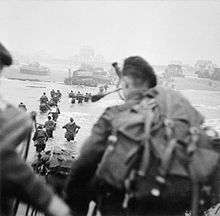
In 1940, the British Army also formed "independent companies", later reformed as battalion sized "commandos", thereby reviving the word. The British intended that their commandos be small, highly mobile surprise raiding and reconnaissance forces. They intended them to carry all they needed and not remain in field operations for more than 36 hours. Army Commandos were all volunteers selected from existing soldiers still in Britain.
During the war the British Army Commandos spawned several other famous British units such as the Special Air Service, the Special Boat Service and the Parachute Regiment. The British Army Commandos themselves were never regimented and were disbanded at the end of the war.
The Special Operations Executive (SOE) also formed commando units from British and displaced European personnel (e.g., Cichociemni) to conduct raiding operations in occupied Europe. They also worked in small teams, such as the SAS, which was composed of ten or fewer commandos because that was better for special operations. One example is Norwegian Independent Company 1, which destroyed heavy water facilities in Norway in 1941.
The Royal Navy also controlled Royal Navy Beach Parties, based on teams formed to control the evacuation of Dunkirk in 1940.[14] These were later known simply as RN Commandos, and they did not see action until they successfully fought for control of the landing beaches (as in the disastrous Dieppe Raid of 19 August 1942). The RN Commandos, including Commando "W" from the Royal Canadian Navy, saw action on D-Day.[15]

In 1942, the Royal Navy's nine Royal Marines infantry battalions were reorganized as Commandos, numbered from 40 to 48, joining the British Army Commandos in combined Commando Brigades. After the war the Army Commandos were disbanded. The Royal Marines form an enduring Brigade-strength capability as 3 Commando Brigade with supporting Army units.[16]
The Royal Air Force also formed 15 commando units in 1942, each of which was 150 strong. These units consisted of trained technicians, armourers and maintainers who had volunteered to undertake the commando course. These RAF commandos accompanied the Allied invasion forces in all theatres; their main role was to allow the forward operation of friendly fighters by servicing and arming them from captured air fields. However, due to the forward position of these airfields, the Royal Air Force Commandos were also trained to secure and make safe these airfields and to help defend them from enemy counterattack.[17]
Australia
The Australian Army formed commando units, known as Australian independent companies in the early stages of World War II. They first saw action in early 1942 during the Japanese assault on New Ireland, and in the Battle of Timor. Part of the 2/1st Independent Company was wiped out on New Ireland, but on Timor, the 2/2nd Independent Company formed the heart of an Allied force that engaged Japanese forces in a guerrilla campaign. The Japanese commander on the island drew parallels with the Boer War, and decided that it would require a 10:1 numerical advantage to defeat the Allies. The campaign occupied the attention of an entire Japanese division for almost a year. The independent companies were later renamed commando squadrons, and they saw widespread action in the South West Pacific Area, especially in New Guinea and Borneo. In 1943, all the commando squadrons except the 2/2nd and 2/8th were grouped into the 2/6th, 2/7th and 2/9th Cavalry Commando Regiments.
Later in the war the Royal Australian Navy also formed commando units along the lines of the Royal Naval Commandos to go ashore with the first waves of major amphibious assaults, to signpost the beaches and carry out other naval tasks. These were known as RAN Commandos. Four were formed—lettered A, B, C and D like their British counterparts—and they took part in the Borneo campaign.
Z Force, an Australian-British-New Zealand military intelligence commando unit, formed by the Australian Services Reconnaissance Department, also carried out many raiding and reconnaissance operations in the South West Pacific theatre, most notably Operation Jaywick, in which they destroyed tonnes of Japanese shipping at Singapore Harbour. An attempt to replicate this success, with Operation Rimau, resulted in the death of almost all those involved. However, Z Force and other SRD units continued operations until the war's end.
New Zealand
New Zealand formed the Southern Independent Commando in Fiji 1942. Its primary function was to wage a guerrilla war on any Japanese forces should they attempt to capture the strategically important Fiji islands. 200 native Fijians were recruited and organised by 44 New Zealanders. Training focused intensely on jungle warfare, and many successful 'mock' raids were made on American garrisons who awoke to find dummy time bombs placed on their ammunition dumps, or chalk crosses drawn on the equipment of their guards.
When it became apparent that a Japanese invasion of Fiji was no longer likely, the commando was deployed to undertake scouting tasks for US forces around Guadalcanal and New Georgia. Recruiting was further expanded to include men from other pacific islands such as the Solomons and Tonga, and occasionally British or American personnel took part in training or accompanied the commandos on missions. After many successful operations and engagements, the harsh conditions of extended jungle living took their toll, and many men began to suffer from ill-health. As a result, the commando was reduced in strength until it was declared unfit for further service, and was disbanded in May 1944.
The commando's contribution to the Solomon Island campaign was significant, with senior American officers referring to the unit as "most capable", "invaluable" and "unquestionably ... of great aid in the campaign".[18]
New Zealanders were also a notable component of the Long Range Desert Group, which undertook reconnaissance and occasional strike missions deep behind enemy lines during the North African Campaign.
Canada
A joint Canadian-American Commando unit, the 1st Special Service Force, nicknamed the Devil's Brigade, was formed in 1942 under the command of Colonel Robert Frederick. The unit initially saw service in the Pacific, in August 1943 at Kiska in the Aleutians campaign. However most of its operations occurred during the Italian campaign and in southern France. Its most famous raid, which was documented in the film Devil's Brigade, was the battle of Monte la Difensa. In 1945, the unit was disbanded; some of the Canadian members were sent to the 1st Canadian Parachute Battalion as replacements, and the American members were sent to either the 101st Airborne Division or the 82nd Airborne Division as replacements or the 474th Regimental Combat Team. Ironically they were sent to service in Norway in 1945, the country they were formed to raid.
Greece
The Sacred band (Greek: Ιερός Λόχος) was a Greek special forces unit formed in 1942 in the Middle East, composed entirely of Greek officers and officer cadets under the command of Col. Christodoulos Tsigantes. It fought alongside the SAS in the Libyan Desert and with the SBS in the Aegean, as well as with General Leclerc's Free French Forces in Tunisia. It was disbanded in August 1945.
United States
During 1941, the United States Marine Corps formed commando battalions. The USMC commandos were known collectively as Marine Raiders. On orders from President Franklin D. Roosevelt through a proposal from OSS Director Colonel William J. Donovan and the former Commander of the United States Marine Detachment Major Evans F Carlson, directed the formation of what became the Marine Raiders. Initially this unit was to be called Marine Commandos and were to be the counterpart to the British Commandos. The name Marine Commandos met with much controversy within the Marine Corps leading Commandant Thomas J. Holcomb to state, "the term 'Marine' is sufficient to indicate a man ready for duty at any time, and the injection of a special name, such as commando, would be undesirable and superfluous." President Roosevelt's son James Roosevelt served with the Marine Raiders. The Raiders initially saw action at the Battle of Tulagi and the Battle of Makin, as well as the Battle of Guadalcanal, the Battle of Empress Augusta Bay, and other parts of the Pacific Ocean Areas. In February 1944 the four Raider battalions were converted to regular Marine units. Additionally, as parachuting special forces units, Paramarines arguably also qualified as commandos[19]- though they too were assimilated into regular Marine units in 1944.
In mid-1942, the United States Army formed its Army Rangers in Northern Ireland under William O. (Bill) Darby. The Rangers were designed along the similar lines to the British Commandos. The first sizable Ranger action took place in August 1942 at the Dieppe Raid, where 50 Rangers from the 1st Ranger Battalion were dispersed among Canadian regulars and British Commandos. The first full Ranger action took place in November 1942 during the invasion of Algiers in Northwest Africa in (Operation Torch), again by members of the 1st Ranger Battalion.[20]
After 1945
After World War II there was much publicity about the deeds of "the commandos"; many civilians reading these accounts, guessing a meaning from the context, thought in error that the singular "a commando" meant one man, and that usage became general.
Australia
In Australia, the Army's commando squadrons were disbanded at the end of the war. However, in 1954, two Citizens Military Force (reserve) units, 1 and 2 Commando Companies, were raised.
1st Commando Regiment (1 Cdo Regt), a regimental structure for the reserve commando companies—and 126 Signal Squadron (Special Forces)—was formed during the 1980s. It adopted the green berets worn by its World War II predecessors.
In 1997, the Australian government ordered the conversion of 4th Battalion, Royal Australian Regiment (4RAR) into a permanent, non-reserve commando battalion, with instructors from 1st Commando Regiment and Special Air Service Regiment (SASR). 126 Signal Squadron was reassigned to 4RAR and 301 Signal Squadron re-raised to join 1 Cdo Regt. In 2009, 4RAR was renamed 2nd Commando Regiment (2 Cdo Regt).
1 Cdo and 2 Cdo utilise identical selection and training courses. One company of 2 Cdo is responsible for counter-terrorism operations and response in eastern Australia and is officially known as Tactical Assault Group-East (TAG-E). This company mirrors its sister unit (the original Tactical Assault Group) in the West (TAG-W), which is part of the SASR.
Commandos from 1CDO and 2CDO have been deployed on peacekeeping and combat missions in several countries, including East Timor, the Solomon Islands, Iraq and Afghanistan.
Austria
The Jagdkommando (lit. Hunting Command) is the Austrian Armed Forces' Special Operations group.
The duties of this elite unit match those of its foreign counterparts, such as the United States Army Special Forces, being amongst others Counter-terrorism and counter-insurgency. Jagdkommando soldiers are highly trained professionals whose thorough and rigorous training enables them to take over when tasks or situations outgrow the capabilities and specialisation of conventional units.
Bangladesh
The 1st Para-Commando Battalion was established by the Bangladesh Army in 1992 from inspiration of Special Air Service. The elite group consists of members from different corps strictly from the Military. Bangladesh Navy has since established the Special Warfare Diving and Salvage in 2009, which is also an elite group of soldiers, similar to the United States Navy SEALs.
Belgium
Commando units belonging to Belgium are the Para-Commando Regiments and Brigade Immediate Reaction Cell.
Canada
Canadian commando forces were disbanded and recreated at various times in the post-war years, and in 1968 the Canadian Airborne Regiment was formed. It was divided into three Airborne Commandos each of company strength. This resulted in a ceiling of about 750 members in all ranks, organized into three smaller company-sized commandos. The three airborne commandos took shape around the three regimental affiliations: 1 Commando with the Royal 22e Régiment, 2 Commando with Princess Patricia's Canadian Light Infantry, and 3 Commando with The Royal Canadian Regiment. The Canadian Airborne Regiment was disbanded after the torture and murder of Shidane Arone, a Somalia civilian, in 1993, and other allegations of wrongdoing within the Regiment. Later, parliamentary investigations questioned why such an elite commando unit was sent on a peacekeeping mission. The Canadian Special Operations Regiment (CSOR) is known as a commando unit but is a special forces unit and Canadian Joint Task Force Two, or JTF2, is also sometimes referred to as a "commando" unit, but it is technically a specialist counter-terrorism unit.
China
- Beijing Military Region-"Oriental Sword" belongs to the Beijing Military Region. All 3000 soldiers in the force complete all types of operations.
- Guangzhou Military Region Special Forces Unit – "South Blade" or "South China Sword" established in 1988 as the People's Liberation Army's first special reconnaissance group, and was later expanded in 2000 to become the first PLA special operations unit to be capable of air-, sea-, and land-operations similar to the U.S. Navy SEALs.[21]
- Chengdu Military Region Special Forces Unit – "Falcon". Established in 1992, this unit is specialised in target locating and indicating, airborne insertion, sabotage and offensive strike, and emergency evacuation.
- Beijing Military Region Special Forces Unit – "Arrow". Established in the early 1990s, this unit is equipped with various "high-tech" equipment including unmanned aerial reconnaissance vehicle (UARV), individual explosion devices and handheld laser dazzling weapons.[21]
- Shenyang Military Region Special Forces Unit – "Siberian Tiger" is capable of completing missions on the ground and in the air and water, as well as surviving in the wilderness alone or in small groups.[21]
- Nanjing Military Region Special Forces Unit – Nickname "Flying Dragon" is the special land force of east China's Nanjing Military Region.
- Nanjing Military Region Special Forces Unit – "Oscar"
- Lanzhou Military Region Special Forces Unit – "Night Tiger" has a long and illustrious history with its origins dating back to World War II. It is home of China's first counter-terrorism unit, established in 2000.[21]
- Jinan Military Region Special Forces Unit – "Eagle"[21] Soldiers of the Eagle special force can complete sea-air-land operations also similar to the U.S. Navy SEALs
- Hong Kong Special Duties Unit – "5 minute Response Unit"
- Macau Quick Reaction Platoon
- Thor (Leishen) Commando Airborne Forces is a crack special force for reconnaissance operations of the PLA's airborne troops, which is capable of performing the tasks of strategic deterrence, combat assault, task operations under IT-based conditions.[22][23]
- PLA Navy's commando team "Sea Dragon" soldiers are equipped with black uniforms, this unit's first publicly known mission was to accompany three Chinese warships in protecting and escorting commercial ships against Somali pirates in December 2008, in cooperation with other nations as part of a UN mandate. Since then, the unit has participated in anti-piracy missions in the Gulf of Eden for over 300 days.[21]
- Leopard is the name given to the crack troops of the Southwest China Falcon special force.
Brazil
Brazil created its special operations forces in the 1950s. There are commando units in the Brazilian Army and in the navy. In the Brazilian Army the main unit is the Special Operations Brigade, and their Navy counterparts are the COMANF, which is a part of the Brazilian Marine Corps.
Chile
In Chile the Army Special Forces, Navy and Air Force commando units are characterized by their black berets and for their use of a special type of knife called a Corvo.
Congo
The former Belgian Congo had one Commando company at independence in 1960 and this was soon expanded to a battalion, becoming known as the 1st Para-Commando Battalion. A 2nd Para-Commando Battalion was added a few years later. From 1963, the Congolese-manned 3rd and 4th Commando Battalions were formed but were little more than normal infantry units. In 1964, the 5th and 6th Commando Battalions were formed mainly with mercenaries, and the 7th to 15th Commando Battalions mainly with Congolese but with some white NCOs and officers. Again, there was no actual commando training and the units were more akin to motorized infantry, with some armour. The 5th to the 15th were all disbanded by 1967.
Denmark
A brief from the Royal Danish Defence College listed two Danish special operations units:[24]
Two other Danish units have some claim to special forces status. The Danish Home Guard's Special Support and Reconnaissance Company is capable of behind-the-lines stay-behind reconnaissance, similar to the Cold War role of the British 21 and 23 SAS Regiments.[27] The Royal Danish Navy also maintains a unique ski patrol unit that conducts dog patrols of Greenland throughout the year. This unit, the Sirius Patrol, maintains a combat capability.
- 2nd Light Reconnaissance Squadron
France
In France, commando is both the name of Special Operations or Special Operations Capable units and the name of an elite light infantry training.

- French Army (Armée de Terre)
The commandos are trained at the Centre national d'entraînement commando or National Commando Training Center. The graduates of the Center are either serving in a SF unit (1er RPIMa and 13e RDP), in a SOC unit (Commando Parachute Group in the 11th Parachute Brigade and Mountain Commando Group in the 27th Mountain Infantry Brigade) or as instructors in a regular Army unit. Furthermore, members of the counter-terrorist National Gendarmerie Intervention Group and of the Black Ops Division (Division Action) of Directorate-General for External Security are usually graduates of the Center. The National Center has three courses of training, commonly called levels : Training, Instructor and Senior Instructor. In order to qualify for a senior course, the candidate must have graduated the junior one(s) with outstanding results.
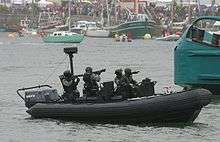
- French Navy (Marine Nationale)
The Commandos Marine are the Navy component of Special Operations Command. They draw their personnel from the Navy Infantry (fusiliers marins) and have their own training pipeline, but they can also train at the Army Training Center.
- Commando Hubert : (also named Commando d'Action Sous-Marine Hubert, CASM, "underwater operations commando"): Submarine action (combat divers).
- Commando Jaubert : Assault at sea, exfiltration, close quarters battle at sea.
- Commando Trepel : Assault at sea, exfiltration.
- Commando de Penfentenyo : Reconnaissance, Intelligence Operations (recon swimmers)
- Commando de Montfort : Long range neutralisation (missile launchers, light mortars, heavy sniper rifles), fire support designation
- Commando Kieffer : C3I, military dogs
- French Air Force (Armée de L'Air).
The Parachute Commandos (commandos parachutistes) are the élite units of the Air Force Infantry (fusiliers de l'Air). They have their own training pipeline, but they can also train at the Army Training Center
- Commando parachutiste de l'Air n° 10 (CPA 10) is the Air Force component of Special Operations Command
- Commando parachutiste de l'Air n° 20 : long-range Bases Protection and JTACs.
- Commando parachutiste de l'Air n° 20 : RESCO
Germany
.jpg)
During the Cold War East Germany's National People's Army had an elite commando unit known as 40. Fallschirmjägerbataillon Willi Sänger. Approximately only 10% of applicants passed both the entrance exam and demanding training. The 40. Fallschirmjägerbataillon was supposedly modeled after the "Rejdoviki," the Soviet special-purpose paratrooper units which were intended to be used for commando operations and for subversion and long-range reconnaissance missions.
The German Army currently operates the Fernspähkompanie (Germany's elite long range reconnaissance company), and the Kommando Spezialkräfte (KSK).
The KSK is stationed in Calw, in the Black Forest area in southern Germany. It consists of about 1,100 soldiers, but only a nucleus of these are in fighting units. Exact numbers are not available, as this information is considered secret. The KSK is a part of the Special Operations Division (Div. Spezielle Operationen or DSO).
The fighting units are divided into four commando companies of about 100 men each and the special commando company with veteran members, taking supporting tasks. Each of the four commando companies has five specialised platoons:
- 1st platoon: land insertions
- 2nd platoon: airborne operations
- 3rd platoon: amphibious operations
- 4th platoon: operations in special geographic or meteorologic surroundings (e.g. mountains or polar-regions)
- 5th platoon: reconnaissance, sniper and counter-sniper operations
- Command Platoon
There are four commando squads in every platoon. Each of these groups consists of about four equally skilled soldiers. One of each group is specially trained as weapons expert, medic, combat engineer or communications expert respectively. Additionally a group can contain other specialists, e.g. heavy weapons or language experts.
Another special unit, the Kampfschwimmer (comparable to the USN SEALs) are operated by the German Navy.
India
The Para Commandos are a special forces unit of the Indian Army. Formed in 1952, the Para Commandos are the largest and most important part of the Special Forces of India. They are highly trained units of the Indian Army, meant to operate behind enemy lines.
The Special Frontier Force is a paramilitary special force of India created on 14 November 1962. Its main goal was to conduct covert operations behind Chinese lines in the event of another Indo-China war. SFF was raised with covert operations in mind, mainly along the Indo-China border, however SFF has been fielded by R&AW and the Indian government in various covert and overt operations.
The Garud Commando Force is the Special Forces unit of the Indian Air Force. The unit derives its name from the word for eagle in Sanskrit. Garud is tasked with acting as quick response teams during attacks on critical Air Force bases and installations; as well as conducting search and rescue of downed pilots, forward air control and carrying out strikes against enemy air defences and radar installations.[28]
MARCOS (marine commandos) is a commando unit of the Indian Navy designed to carry out operation from the air, at sea and on land.
National Security Guards is a special force in India that has primarily been utilised for counter-terrorism activities. (NSG) personnel are popularly known as Black Cat Commandos. There are 2 main units of the NSG, The Special Action Group (SAG) and The Special Ranger Groups (SRG). The Special Action Group is the strike force in anti-terrorist and hostage rescue operations. The Special Rangers Group (SRG) is tasked with providing VVIP security for high-risk VVIPs in India.
Ghatak Force is a battalion-level special platoon in the Indian Army, with one in each battalion. They are used as elite infantry to spearhead attacks, carry out reconnaissance and further the objectives of battalions on the battlefields.
The SOG (Special Operations Group (India)) is a special forces unit of the Jammu and Kashmir Police involved in counter terror activities in the state.
The Force One is an elite commando force, which is a specialised counter terrorism unit to guard the Mumbai metropolitan area, one of the largest metropolitan areas in the world, formed by the Government of Maharashtra on the lines of the National Security Guards (NSG).
Kerala Thunderbolts is an elite commando force, which specialises in counter terrorism and Anti-naxel activities, formed by the Government of Kerala on the lines of the National Security Guards.[29]
Special Tactical Unit is an urban counter terrorist unit based in Odisha, India. They specialise in urban warfare scenarios including hostage situations.
Indonesia
Army
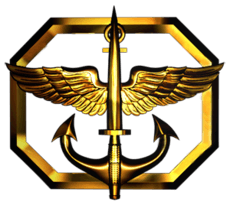
Kopassus
A portmanteau of Komando Pasukan Khusus or "Special Forces Command", is an Indonesian Army (TNI-AD) special forces group that conducts special operations missions for the Indonesian government, such as direct action, unconventional warfare, sabotage, counter-insurgency, counter-terrorism, intelligence gathering and Special reconnaissance. Kopassus was founded on 16 April 1952 and like other special units within the TNI, it is able to conduct military operations in different dimensions namely Land, Sea, and Air. It gained worldwide attention after several operations such as during the Indonesian invasion of East Timor and hostage release of Garuda Indonesia Flight 206.
Navy
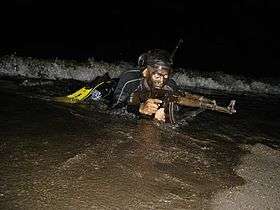
Taifib
Taifib (Indonesian: Batalyon Intai Amfibi) is an elite recon unit within the Indonesian Marine Corps which is tasked for conducting Amphibious reconnaissance and Special reconnaissance. It is operationally similar to the Combat Reconnaissance Platoon (Indonesian: Peleton Intai Tempur, abbreviated "Tontaipur") from the Army's Kostrad corps. Taifib was previously known as "Kipam" (abbreviation from: "Komando Intai Para Amfibi") which literally means in English: the Para-Amphibious reconnaissance Commandos, it was formed on 1961 under the auspices of the Indonesian Navy and like other special units within the TNI, it is able to conduct military operations in different dimensions namely Land, Sea, and Air.
Air Force

Paskhas
Paskhas is the air force infantry and special forces corps of the Indonesian Air Force (TNI-AU). Paskhas is trained to conduct Commando and air-oriented operations such as Combat-control team, airfield control and defense, combat search and rescue, Jumpmaster, airborne, ground-forward air control, High-altitude military parachuting, Air assault, and Direct action. They also can operate as Air Traffic Controllers (ATC) in certain situations. The corps was founded in the 17th of October 1947 and like other special units within the TNI, it is able to conduct military operations in different dimensions namely Land, Sea, and Air.
Iran
Revolutionary Guards
.jpg)
In the Islamic Revolutionary Guard Corps (IRGC), one of its five branches, the elite Quds Force specialises in extraterritorial operations.[30] In the Ground Forces, the Saberin Battalion is the most famous special unit.[31][32] The Islamic Revolutionary Guards Corps Navy has its own Special Units of marines.[33]
Army
.jpg)
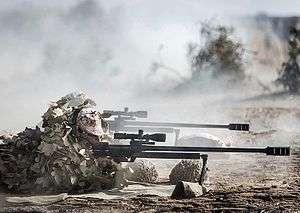
Ground Forces of Islamic Republic of Iran Army units whose members are trained at Lashkarak Takavar Training Centre:
- 23rd Takavar Division based in Parandak
- 58th Takavar Division (Zolfaghar Division) based in Shahroud
- 25th Takavar Brigade based in Pasveh
- 35th Takavar Brigade based in Kermanshah
- 45th Takavar Brigade based in Shushtar
- 55th Airborne Brigade based in Shiraz
- 65th Airborne Special Forces Brigade (NOHED Brigade) based in Tehran. Mashregh News considers the unit one of the top ten commando units in the world.[34]
Islamic Republic of Iran Navy green berets/marines (Persian: تکاوران دريايي) whose members are trained at Manjil Takavar Training Centre:
- 1st Marine Brigade (Imam Hossein Brigade) based in Bandar Abbas
- 2nd Marine Brigade (Hazrat Rasul-i-Akram Brigade) based in Bushehr
- 3rd Marine Brigade (Hamza Sayyid-ush-Shuhda Brigade) based in Konarak
During the reign of the last Shah (king) of Iran, much of the naval training was created by members of the Soviet Union's Spetsnaz and the British Special Boat Service.[35] Training is at least a 12-month process. After the recruit has demonstrated the minimum physical requirements, he is sent to a collection of schools.[36]
Iraq
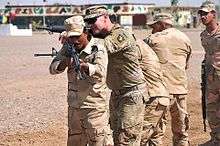
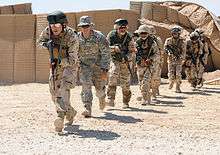
On 31 August 2016, Clarksville Online reported U.S. soldiers from the 1st Battalion, 502nd Infantry Regiment, Task Force Strike, 101st Airborne Division (Air Assault), took charge of a Ranger training program for qualified volunteers from Iraqi security forces at Camp Taji, Iraq. The Ranger training program, led by Company A, 1-502nd, is designed to lay the foundation for an elite Iraqi unit.[37]
Israel

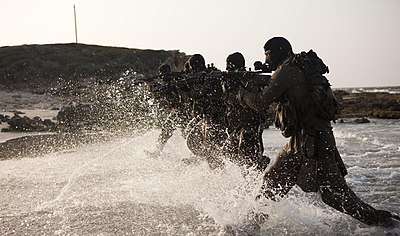
The primary commando units of the Israel Defense Forces include Shayetet 13, Sayeret Matkal and the Shaldag Unit.
Shayetet 13 is the elite naval commando unit of the Israeli Navy. S'13 specializes in sea-to-land incursions, counter-terrorism, sabotage, maritime intelligence gathering, maritime hostage rescue, and boarding.The unit is respected as among the best of the world's special forces.[38]
Sayeret Matkal (General Staff Reconnaissance Unit) is a special forces unit of the Israel Defense Forces (IDF) directly subordinate to the Directorate of Military Intelligence.
Primarily a field intelligence-gathering unit specializing in special reconnaissance behind enemy lines, Sayeret Matkal is also tasked with counter-terrorism, hostage rescue, and foreign espionage. Modeled after the British Army's Special Air Service—from which it emulated the motto, "Who Dares, Wins"—the unit is considered to be the Israeli equivalent to the famed Delta Force of the United States.[39]
As one of Israel's most elite commando units, Sayeret Matkal has reputedly been involved in almost every major counter-terrorism operation since its inception in 1957.[40]
The Paratroopers Brigade also known as the 35th Brigade, is an elite unit of paratroopers within the Israel Defense Forces (IDF), and forms a major part of the Infantry Corps. It has a history of carrying out special forces-style missions dating back to the 1950s. Sayeret Tzanhanim is Israel's elite reconnaissance paratroopers in the mold of U.S. Army Rangers. They have conducted numerous black operations over the years.
The Egoz Reconnaissance Unit is an Israeli Special Force commando unit, in the Israel Defense Forces (IDF). Egoz is a unit that specializes in guerrilla, anti-guerrilla warfare, behind enemy lines intelligence gathering, and more complicated ground activity. Egoz is part of the Commando Brigade but still completes basic training with the Golani Brigade.[41]
The Golani Brigade, also known as the 1st Brigade, is an Israeli regular service infantry brigade that is subordinated to the 36th Division and traditionally associated with the Northern Command. It is one of the five regular service infantry brigades of the Israel Defense Forces (IDF). Its symbol is a green olive tree against a yellow background, with its soldiers wearing a brown beret. It is one of the most highly decorated infantry units in the IDF. The brigade consists of five battalions, including two which it kept from its inception (12th and 13th), one transferred from Givati (51st), and two special forces battalions.
Maglan (Also known as Unit 212 or Sayeret Maglan) is an Israeli special forces unit which specializes in operating behind enemy lines and deep in enemy territory using advanced technologies and weaponry.
Unit 217, frequently called Duvdevan Unit is an elite special operations force within the Israel Defense Forces, part of the Commando Brigade. Duvdevan are noted for undercover operations in urban areas, during which they often wear Arab civilian clothes as a disguise.[42] They are also known to be trained in human and mechanical counter-surveillance. Along with Sayeret Matkal, soldiers in Duvdevan are the only soldiers in the IDF authorized to wear their uniforms without identifying shoulder tabs.
The Alpinist Unit is a special Israeli Defence Force infantry reserve unit, under the command of the Israeli Northern Command, specializing in mountain warfare, snow warfare and difficult terrain warfare in the northern front, especially Mt. Hermon.[43]
Shaldag Unit, also known as Unit 5101, is an elite Israeli Air Force commando unit. Shaldag's mission is to deploy undetected into combat and hostile environments to conduct special reconnaissance, establish assault zones or airfields, while simultaneously conducting air traffic control and commando actions.
Israel's premier commando unit of the Haganah, the forerunner of the modern IDF, was the Palmach. The first special forces unit created after Israel's independence was Unit 101.
Italy
Malta
Netherlands
Norway
- Norwegian Special Operations Command (NORSOCOM)[44]
- Marinejegerkommandoen (MJK)[45]
- Forsvarets Spesialkommando (FSK)[46]
- Kystjegerkommandoen (KJK)
Pakistan

The Special Service Group (SSG) is an independent commando division of the Pakistan Army. It is an elite special operations force. Official numbers are put at 2,100 men, in 3 Battalions; however the actual strength is classified. Based at Cherat and Attock, the SSG was created in 1956 with active support from U.S. Special Operations Forces. That year the 19th Battalion of the Baloch Regiment (19 Baloch) was selected for conversion to a Special Operations Force.
The SSG also has a unit in the Pakistan Navy known as the Special Service Group Navy (SSGN). The SSGN currently maintains its headquarters in Karachi and is headed by a Pakistan Navy Commander. In 2006, the SSGN created two new groups, the Pak Seals and VBSS. The Pak Seals will operate at sea, from the air and on land.
The SSG in 2001 created a special forces unit for the Pakistan Air Force called the Special Service Wing (SSW). This new component of the Special Forces of Pakistan is still being trained and built up.
Poland
Portugal

The Portuguese Armed Forces, presently, include the following commando type forces: the Comandos Troops, the Parachute Troops, the Corpo de Fuzileiros.
The first modern commando type force created by the Portuguese Army was the Sapadores de Assalto (Assault Sappers), a small assault sub-unit organized inside the Army School of Engineers, by the then captain Kaulza de Arriaga, in 1947. However, the majority of the Army was opposed to the existence of special forces and the Sapadores de Assalto were soon extinct.
Later, Kaulza de Arriaga, would be appointed the first Secretary of the Air and – in this role – created the Portuguese Parachute Troops in 1956, with commando features, as part of the Portuguese Air Force and not of the Army.
In 1960, the Army created again a commando type unit, the Caçadores Especiais (Special Rifles). The Caçadores Especiais would fight in the beginning of the Portuguese Overseas War in Africa. However, the Army faction opposed to the existence of special forces prevailed again and the decision was taken to extinct the Caçadores Especiais and to extend the training given to those units to all the field units of the Army.
It was soon found impossible to train all units as Caçadores Especiais. This originated the creation of the Comandos. The first of these forces were created in Northern Angola in 1962, initially as shock sub-units of regular field battalions and later as independent units. The Comandos were designed to conduct special actions in the Portuguese territory or abroad, to fight as assault infantry / shock troops and to provide the high political and military commands with a force able to conduct irregular operations.
Beyond the above-mentioned, the Portuguese Armed and Security Forces organized and employed several other commando type forces in the Overseas Wars in Angola, Mozambique and Portuguese Guinea, including the Fuzileiros Especiais (Special Marines) of the Portuguese Navy, the Flechas (Arrows) of the International and State Defense Police and the Grupos Especiais (Special Groups) of the Government of Mozambique.
Rhodesia
During the Rhodesian Bush War of 1965–1980, the Rhodesian military increased its usage of commando type of operations in fighting against insurgents until the formation of Zimbabwe. In the Rhodesian Light Infantry a Commando was also the name given to its company sized units.
Russia
Russia has several units that can be listed under the commando distinction. The 45th Detached Reconnaissance Brigade is a special reconnaissance and special operations military unit within the Russian Airborne Troops, and based near Moscow. Other specialized Russian units include:
.jpg)

- 7th Guards Air Assault (Mountain) Division in Novorossiysk (108th, 247th Regiments)
- 76th Guards Air Assault Division in Pskov
- 98th Guards Airborne Division in Ivanovo
- 106th Guards Airborne Division in Tula
- 11th Guards Airborne Brigade in Ulan-Ude
- 31st Guards Airborne Brigade in Ulyanovsk (planned to be reflagged as 104th Guards Airborne Division)
- 56th Guards Airborne Brigade in Kamyshin
- 83rd Guards Airborne Brigade in Ussuriysk
- 242nd Training Centre of the VDV in Omsk
- 38th Guards Airborne Signal Brigade in Medvezhi Ozera
- Russian Naval Infantry
- Multiple Spetsnaz Units
Sri Lanka
South Africa
While the use of the word commando came to refer to various elite special operations forces units in other countries in the world, South Africa retained its original name as both a well regulated quick response militia as well as a special operations forces unit defined in the worldwide fashion. From the end of the 19th until the early 21st centuries, the Commando units in the form of its original structure were used in both urban and rural areas until the end of white rule in South Africa as part of a nationwide South African Commando System.
When white rule was replaced with majority rule, the new democratic ANC led government demanded the disbandment of the commandos which they considered an obstacle to further democratic control as well as complaints of abuses. Thus, with the integration of white cities with black townships, the new ANC led urban governments immediately disbanded the urban militia commando units.
With the election of Thabo Mbeki, the process of de-arming white militias again commenced and it was announced in 2003, that the rural commandos would be disbanded. The last rural commandos were ordered disbanded by the central government over constitutional arguments.
The ANC government directed its attention toward the Reconnaissance Commandos which were the first mixed-race unit in the old SADF. During the period of rationalisation, reorganisation and integration, some Reconnaissance Regiments (Numbers 1, 2, 3, 5 and 6) were disbanded and the members absorbed into the remaining 4 Special Forces Regiment (SFR) at Langebaan and 5 SFR at Phalaborwa[47] as part of the South African Special Forces Brigade.
Sweden
- Special Operations Task Group (SOG)[48]
- Life Regiment Hussars (K3)
- 32. Reconnaissance Battalion
- Parachute Ranger Company (FJS)[49]
- 31st Airborne Battalion
- Amphibious Corps
- 1st Marine Regiment (Amf 1)
- Coastal rangers (Kustjägarna) or KJ [50]
Turkey
According to 2008 formations there are 5 commando brigades in the Turkish Army. The most notable are the 1st Commando Brigade and the Hakkari Mountain and Commando Brigade. Turkish commandos typically wear blue berets.
The 1st Commando Brigade was involved in the Turkish invasion of Cyprus, and fought beside airborne commandos (Bolu) and the Naval Infantry Brigade (Izmir). In 1988, 7000 commandos received training from the United States.
The Hakkari Mountain and Commando Brigade was founded as a subunit of the 2nd Commando Brigade and is stationed in Hakkâri Province at south-easternmost Turkey. With the rise of the Kurdish insurgency, the existing formation has been enlarged from the size of a battalion to a brigade.
Ukraine
The Ukrainian Airmobile Forces or VDV (from "Vysokomobil'ni desantni viyska Ukrayiny", Ukrainian: Високомобільні десантні війська України, ВДВ; High-mobile Airborne Forces of Ukraine) is a highly mobile component of the Ukrainian Ground Forces. The airmobile forces consist of formations, units and elements of the Army and the Army aviation, trained for combined activities behind the enemy lines. The airmobile forces are in constant combat readiness and are the high mobility branch of forces. The 79th Airmobile Brigade recently won fame in 2014. The Brigade took part in suppressing the 2014 insurgency in Donbass during the 2014 pro-Russian conflict in Ukraine.[51] The brigade fought in the Second Battle of Donetsk Airport, where it and other Ukrainian military units became known as the "Cyborgs" due to their stubborn defense of the Donetsk Airport. Other Ukrainian units that partake in commando operations:
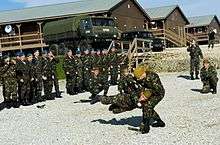
United Kingdom
The Special Air Service (SAS) is a special forces unit of the British Army. The SAS was founded in 1941 as a regiment, and later reconstituted as a corps in 1950.[53] The unit undertakes a number of roles including covert reconnaissance, counter-terrorism, direct action, hostage rescue and human intelligence gathering.[54][55]
The corps presently comprises 22 Special Air Service Regiment, the regular component, under the operational command of United Kingdom Special Forces, and 21 (Artists) Special Air Service Regiment (Reserve) and 23 Special Air Service Regiment (Reserve), which are reserve units under the operational command of 1st Intelligence, Surveillance and Reconnaissance Brigade.[56]
The Special Boat Service (SBS) is described as the naval special forces of the United Kingdom and the sister unit of the SAS. The operational capabilities of both units are broadly similar, however, the SBS (being the principal Royal Navy contribution to UKSF) has the additional training and equipment to lead in the maritime, amphibious and riverine environments. Both units come under the operational command of HQ Directorate of Special Forces (DSF) and undergo an identical selection process, enjoy significant interoperability in training and on operations.
3 Commando Brigade, Royal Marines is under the command of the Royal Navy's Commander-in-Chief Fleet. All Royal Marines (other than those in the Royal Marines Band Service) are commando trained on entry to the Corps, with supporting units and individuals from the other armed services undertaking the All Arms Commando Course as required.
The Brigade is made up of 30 (IX) Commando, 40 Commando (home base: Taunton), 42 Commando (Bickleigh, South Hams, Plymouth), 43 Commando Fleet Protection Group (HMNB Clyde, Argyll and Bute), 45 Commando (Arbroath, Scotland), the Commando Logistic Regiment, the Royal Marines Armoured Support Group (Bovington Camp (Royal Armoured Corps Centre), Dorset), 539 Assault Squadron RM, 29 Commando Regiment Royal Artillery and 24 Commando Regiment Royal Engineers. The Royal Marines is the largest force of its type in Europe and the second largest in NATO. The Royal Marines also have an elite reconnaissance unit known as Brigade Patrol Troop.
The Parachute Regiment, colloquially known as the Paras, is an elite airborne infantry regiment of the British Army. One battalion is permanently under the command of the Director Special Forces in the Special Forces Support Group. The other battalions are the parachute infantry component of the British Army's rapid response formation, 16 Air Assault Brigade. The Paras are the only line infantry regiment of the British Army that has not been amalgamated with another unit since the end of the Second World War.[57]
16 Air Assault Brigade is a formation of the British Army based in Colchester in the county of Essex. It is the Army's rapid response airborne formation and is the only Operational Brigade in the British Army capable of delivering Air Manoeuvre, Air Assault and Airborne operations.
It is the only airborne brigade within the British Army (outside the special forces); and, in line with current Dress Regulations, all personnel in the brigade wear the maroon beret, while personnel who are qualified as military parachutists wear the appropriate Parachutist Badge.
United States

.jpg)
The United States continues to have no designated "commando" units; however, the closest equivalents remain the U.S. Army's 75th Ranger Regiment and United States Marine Corps Reconnaissance Battalions, which specialize in most of the same tasks and missions.[58] The U.S. 75th Ranger Regiment is a light infantry, special operations unit of the United States Army. The regiment is headquartered at Fort Benning, Georgia and is composed of one special troops battalion and three ranger battalions. The regiment is the U.S. Army's premier raid force, with specialized skills that enable them to perform a variety of missions. These include direct action, airfield seizure, airborne and air assaults, special reconnaissance, personnel recovery, and high-value target raids. It operates as a special operations force under the United States Army Special Operations Command.[59]
The United States Marine Corps Reconnaissance Battalions (or commonly called Marine Recon) are the Special Operations Capable reconnaissance assets of Marine Air-Ground Task Force that provide division-level ground and amphibious reconnaissance to the Ground Combat Element within the United States Marine Corps. Division reconnaissance teams are employed to observe and report on enemy activity and other information of military significance in close operations.
During the Vietnam War the U.S. Army's 5th Special Forces Group (Airborne) instituted, "Special Operations Augmentation Recondo School," an acronym for Reconnaissance Commando. The school was at Nha Trang Air Base, north of the massive U.S. Navy and Air Force Base at Cam Ranh Bay. Recondo School trained small, heavily armed long-range reconnaissance teams the art of patrolling deep in enemy-held territory. All students were combat veterans and came from the ranks of the U.S. Army, U.S. Marine Corps Force Recon Battalions, and the Army of the Republic of South Korea. The Army of the Republic of Vietnam had their own school. Currently the training mission of LRRPs type units is by the U.S. Army Ranger Training Brigade, Reconnaissance and Surveillance Leaders Course, Fort Benning, Georgia. The U.S. Navy SEALs are also well known by the general public especially for their capture of Osama Bin Laden. That particular operation was conducted by the secretive SEAL Team Six.

Tiger Force was the nickname of a Long-range reconnaissance patrol unit[60] of the 1st Battalion (Airborne), 327th Infantry Regiment, 1st Brigade (Separate), 101st Airborne Division, which fought in the Vietnam War.[61] Their high bodycounts were recognized and encouraged by military officials. Their commander Col. Morse ordered troops to rack up a body count of 327 casualties in order to match the battalion's infantry designation, 327th; however by the end of the campaign soldiers were congratulated for their 1000th kill.
The platoon-sized unit, approximately 45 paratroopers, was founded by Colonel David Hackworth in November 1965 to "outguerrilla the guerrillas".[62] Tiger Force (Recon) 1/327th was a highly decorated small unit in Vietnam, and paid for its reputation with heavy casualties.[63] In October 1968, Tiger Force's parent battalion was awarded the Presidential Unit Citation by President Lyndon B. Johnson, which included a mention of Tiger Force's service at Đắk Tô in June 1966.[64]
Vietnam
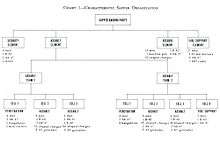
The North Vietnamese produced some of the most effective commando units (sometimes known as sappers) of the post World War II era. Called đặc công, these units represented a force economy measure for the NVA (North Vietnamese Army) and the Viet Cong. With large scale conventional attacks increasingly untenable, small commando operations came into their own, particularly after the Tet Offensive, and at times inflicted severe damage to US and ARVN troops and bases.[65]

Commandos were originally supporting adjuncts to regular formations prior to 1967, but in time, independent formations were created throughout the Vietnam arena. Commandos could operate in support of a larger regular infantry formation, or as the main spearhead themselves, with regulars as backup. In the spearhead mode, they represented their most potent threat.[65] A typical raiding operation was divided into 4 elements: Assault, Fire-Support, Security and Reserves. Assault teams were generally broken down into three-five man cells. Fire-support was critical, as it forced defenders to keep their heads down, while infiltrating assault elements made their final penetrations. One of the most devastating attacks was against the US Firebase, FSB Mary Ann in 1971.[66] See chart for detailed breakdown of a typical commando raiding party. In addition, they also conducted a commando attack on the U.S. military airport in Thailand. The United States recorded a total of five attacks on airfields in Udorn, Ubon (three times) and Utapao. According to the United States the attack caused heavy damage to Udorn on a C-141, damage to some F-4s, minor damage to a helicopter HH-43. Attacks on Ubon destroyed 2 C-47 aircraft and a truck. At Utapao, a B-52 was damaged and two other B-52 bombers suffered minor damage. These are just a few examples out of many successful raids.
While small in terms of total men deployed throughout the Vietnam theater, commando attacks had a significant impact for the NLF/PAVN effort. As one US Army history puts it:[65]
From the beginning of 1968 until mid-1969, sappers were essential to the North Vietnam war effort. Although they participated in only four percent of all assaults, these made up twelve percent of all significant assaults—those that inflicted serious damage. In 1969, the average raid inflicted more than $1,000,000 damage and accounted for more allied casualties.
The modern era Vietnam Naval Commandos are better known as "đặc công nước". Chinese sources believe that the Vietnam Naval Commandos just might be the best Special Forces unit in Asia.[67]
The unit initially known as the 126 Frogmen Division or the "Naval Engineers Regiment 126" which was established in 1969.[67] It is said that the Vietnam Naval Commandos sank multiple U.S. and Republic of Vietnam ships during the Vietnam war. This Division was later known as the Brigade of Marines 126. Vietnam Naval Commandos supposedly have two brigades based in Long An and Khanh Hoa. Annually the division welcomes about 30-50 special elite frogmen.[67] The Dac Cong Nuoc specialize in reconnaissance, ambushes, raids, assassinations, and demolitions.
Later in the Sino–Vietnamese War and a series of 1979–90 border war with China, Vietnamese commandos had raided into Chinese territory and destroyed many Chinese weapons and ammunition of the People's Liberation Army, which had concerned China over the Vietnamese commandos' sudden attacks. Also, it raised concerns of the abilities of Chinese military to protect its ammunition which was relatively not modernized and relied much on the other supplies.
Today, the Vietnamese Commando Forces remains as a military specific group which is comprised into the People's Army of Vietnam. Even it is still in question at modern day, Vietnamese Commandos have been an inspirational figures among Vietnam.
Northern Ireland
During the Northern Ireland conflict the Provisional IRA's East Tyrone Brigade used Commando style units similar to those used by the Viet Cong & NVA to attack US Army bases the IRA used them to launch assaults on British Army & Police bases to create "liberated zones", examples are the Attack on Ballygawley barracks, Attack on RUC Birches barracks & the Attack on Derryard checkpoint in which up to 20 IRA volunteers took part in using assault rifles, heavy machine guns, hand-grenades & a flame-thrower.[68]
In popular culture
- Commando was a 1985 film starring Arnold Schwarzenegger and Rae Dawn Chong
- Commando Comics, a line of action/adventure comic books[69]
- Tiny Commando, a comedy series featuring the adventures of Tiny Commando, a wealthy military-trained crimefighter[70]
- The 1968 film Commandos, starring Lee Van Cleef, depicts a commando raid during World War II.
See also
References
- 1 2 3 4 5 6 "The Word 'Commando'", Dobbie, Elliott V. K., American Speech, 19 2 Apr. 1944, 81-90, https://www.jstor.org/stable/487007
- ↑ Encyclopædia Britannica (14th ed.), Vol. 6, p. 106
- ↑ "Commado". Oxford English Dictionary (online ed.).
- ↑ "On Commando", Dietlof Van Warmelo, Methuen, 1902
- ↑ "Commandeer – Definition and More from the Free Merriam-Webster Dictionary". Mw4.merriam-webster.com. Retrieved 2012-04-19.
- ↑ Meyers, Bruce F (2004). Swift, Silent, and Deadly: Marine Amphibious Reconnaissance in the Pacific. Naval Institute Press. ISBN 978-1-59114-484-7.
- ↑ "Gli Arditi del Popolo: la storia". www.storiaxxisecolo.it. Retrieved 16 May 2017.
- ↑ McNab P.50
- ↑ Commando Country, Stuart Allan, National Museums Scotland 2007, ISBN 978-1-905267-14-9
- ↑ Raids in the Late War and their Lessons, R. Laycock, Journal of the Royal United Service Institution November 1947 pp 534-535
- 1 2 3 4 5 Spetsnaz:Russia's Special Forces by Mark Galeotti
- ↑ Heroes of the Soviet Union 1941-45 by Henry Sakaida
- ↑ "World War II | Royal Naval Commandos in World War II". TheHistoryNet. 2006-06-12. Retrieved 2012-04-19.
- ↑ "Beach Organisation for the Invasion of Normandy, 1944". Archived from the original on January 13, 2009.
The Royal Navy Beach Commandos controlled the arrival and departure of vessels that were landing their cargoes on the beaches. In each RN Beach Commando was a Principal Beachmaster (PBM), an Assistant Principal Beachmaster and two or three beach parties each consisting of a Beachmaster, two Assistant Beachmasters and about 20 seamen.
- ↑ Neillands, Robin. The Raiders — the Army Commandos 1940-46. Weidenfeld & Nicolson. ISBN 978-0-297-79426-4.
- ↑ http://www.raf.mod.uk/dday/scus.html Archived September 15, 2013, at the Wayback Machine.
- ↑ Colin R. Larsen. "Pacific Commandos: New Zealanders and Fijians in Action. A history of Southern Independent Commando and First Commando Fiji Guerrillas". NZETC.
- ↑ Thompson, Leroy (11 February 2001). America's Commandos: U.S. Special Operations Forces of World War II and Korea. Frontline Books. ISBN 9781853674587. Retrieved 16 May 2017 – via Google Books.
- ↑ Thomson, W.R., "Massacre at Dieppe," History of the Second World War, BPC Publishing, LTD, London, GB, 2nd ed., 1972.
- 1 2 3 4 5 6 The PLA's special forces: secrets revealed, archived from the original on 2015-06-30
- ↑ "Newscontent". 220.181.168.86. Retrieved 16 May 2017.
- ↑ Jianing, Yao. "Chinese airborne troops win glory in int'l special forces competition". english.chinamil.com.cn. Retrieved 16 May 2017.
- ↑ Special operations – myths and facts Archived 2014-05-17 at the Wayback Machine., p.7
- ↑ Forside. Forsvaret.dk. Retrieved on 8 September 2011.
- ↑ Kongsøre Archived 2008-03-31 at the Wayback Machine.. Forsvaret.dk (24 September 2010). Retrieved on 8 September 2011.
- ↑ Hjemmeværnet – SSR – Særlig Støtte og Rekognoscering. Hjv.dk. Retrieved on 8 September 2011.
- ↑ "Constitution of Commando Force" (Press release). Press Information Bureau, Government of India. 18 December 2003. Retrieved 2008-07-25.
- ↑ "Eagles have landed". MiD DAY. 2009-11-09.
- ↑ "Qods (Jerusalem) Force". Federation of American Scientists Intelligence Resource Program. August 21, 1998. Archived from the original on 18 February 1999.
- ↑ "يگان ويژه "صابرين" چيست و چگونه مي توان عضو آن شد؟". Mashregh News. Retrieved 15 July 2015.
- ↑ "همکاري نوهد ارتش و صابرين سپاه". Mashregh News. Retrieved 15 July 2015.
- ↑ "همايش تفنگداران و تکاوران دريايي سپاه آغاز شد". Fars News Agency. Retrieved 15 July 2015.
- ↑ "Army Reviews Media Strategy for Syrian Operations". iranwire.com. Retrieved 16 May 2017.
- ↑ "Takavaran, Naval Commandos". Special Operations. Com. Archived from the original on 29 November 2011. Retrieved 15 July 2015.
- ↑ "گزارشي از مرکز آموزش تکاوران کلاه سبز/نيروي دريايي ارتش چگونه کلاه سبز تربيت مي کند+عکس". Mashregh News. Retrieved 15 July 2015.
- ↑ "101st Airborne Soldiers build elite Iraqi force with Ranger Training". clarksvilleonline.com. 31 August 2016. Retrieved 16 May 2017.
- ↑ Mahnaimi, Uzi; Jenkins, Gareth (2010-06-06). "Operation calamity". The Times. London. Retrieved 2010-06-07.
- ↑ "Sayeret Matkal – Israeli Special Operations". Retrieved 2008-07-27.
- ↑ Cohen, Rich. "Stealth Warriors". Vanity Fair. Retrieved 27 April 2016.
- ↑ "IDF to unite elite units in new commando brigade". ynet. Retrieved 2015-11-26.
- ↑ Steve Macko, The IDF Duvedevan Unit Archived 2007-11-25 at the Wayback Machine., Emergency Response & Research Institute (August 11, 1997)
- ↑ "Two Eilat bombing victims laid to rest". Jerusalem Post. Retrieved 2008-06-07.
- ↑ deBlanc-Knowles, Tess (6 October 2015). "Creation of a Norwegian SOCOM: Challenges and Opportunities". Global SOF Foundation. Archived from the original on 17 September 2016. Retrieved 17 September 2016.
- ↑ "Marinejegerkommandoen". forsvaret. Retrieved 22 August 2015.
- ↑ "Forsvarets spesialkommando feiret 50-års-jubileum". Retrieved 22 August 2015.
- ↑ Special Forces League, SA. "1 RR/1 SFR History". Special Forces League. Archived from the original on 2014-06-16. Retrieved 2014-04-28.
- ↑ "Inside Secret Raids Performed By Swedish Special Operators". Business Insider. 4 February 2014. Retrieved 3 January 2015.
- ↑ (in Swedish)Creation of Särskilda operationsgruppen – a new Special Forces Unit from Swedish Army website Archived 2011-11-06 at the Wayback Machine.
- ↑ Sof, Eric (30 October 2012). "Kustjägarna".
- ↑ "Кроме нас им никто не поможет, – волонтеры собирают материальную помощь николаевским десантникам, находящимся в зоне АТО". news.pn. Retrieved 16 May 2017.
- ↑ "Сергій Машковський привітав військовослужбовців 199 навчального центру ВДВ ЗСУ" [199th Training Center Airmobile Forces welcomed by Sergey Mashkovsky]. oda.zt.gov.ua (in Ukrainian). Retrieved 2016-03-25.
- ↑ "Brief history of the regiment". Special Air Service Association. Retrieved 21 January 2011.
- ↑ Griffin, pp.150–152
- ↑ Adams, p.102
- ↑ Army Briefing Note 120/14, NEWLY FORMED FORCE TROOPS COMMAND SPECIALIST BRIGADES, Quote . It commands all of the Army's Intelligence, Surveillance and EW assets, and is made up of units specifically from the former 1 MI Bde and 1 Arty Bde, as well as 14 Sig Regt, 21 and 23 SAS(R).
- ↑ "The Parachute Regiment". Ministry of Defence (United Kingdom). Archived from the original on 21 February 2011. Retrieved 2 March 2011.
- ↑ Plaster, John (Sep 7, 2010). SOG: The Secret War of America's Commandos in Vietnam. New York: NAL Trade.
- ↑ Army Command and General Staff College. "Special Operations Forces Reference Manual Chapter 3: US Army Special Operations Forces". Federation of American Scientists.
- ↑ p. 33 Rottman, Gordon L. US Army Long-Range Patrol Scout in Vietnam 1965-71 Osprey Publishing, 2008
- ↑ Sallah and Weiss, Tiger Force, 22–23.
- ↑ Sallah and Weiss, Tiger Force, 13–14, 23, 224.
- ↑ Mahr, "Unit's founder".
- ↑ U.S. Army, "101st Airborne Division".
- 1 2 3 Major General David Ewing Ott, (1975), "FIELD ARTILLERY, 1954-1973", United States Army Center of Military History, Vietnam Studies, WASHINGTON, D.C.: DEPARTMENT OF THE ARMY, pp. 1–13
- ↑ Keith William Nolan, Sappers In the Wire: The Life and Death of Firebase Mary Ann, (Texas A&M University Press: 1995) pp. 23-119, 200-245
- 1 2 3 Báo Trung Quốc: Đặc công nước Việt Nam mạnh ngang SEAL (in Vietnamese)
- ↑ Sutton, Malcolm. "CAIN: Sutton Index of Deaths". cain.ulst.ac.uk. Retrieved 2 May 2018.
- ↑ "Commando: War Comic For Action and Adventure". Commando Comics. Retrieved 2 May 2018.
- ↑ "Tiny Commando home page". yahoo.com. Archived from the original on 23 August 2013. Retrieved 16 May 2017.
External links
- https://en.iranwire.com/features/7206/
- http://giaoduc.net.vn/Quoc-te/Giao-duc-Quoc-phong/Bao-TQ-ca-ngoi-kha-nang-cua-dac-cong-Viet-Nam-de-de-be-vu-va-post145924.gd
- http://baodatviet.vn/quoc-phong/quoc-phong-viet-nam/bao-trung-quoc-dac-cong-nuoc-viet-nam-manh-ngang-seal-3307531/
- Special Forces @ Discover Military
- http://www.globalsecurity.org/military/ops/enduring-freedom_deploy.htm
- http://drrichswier.com/2014/05/27/u-s-special-operations-forces-special/
- http://english.chinamil.com.cn/news-channels/china-military-news/2015-07/10/content_6581621.htm